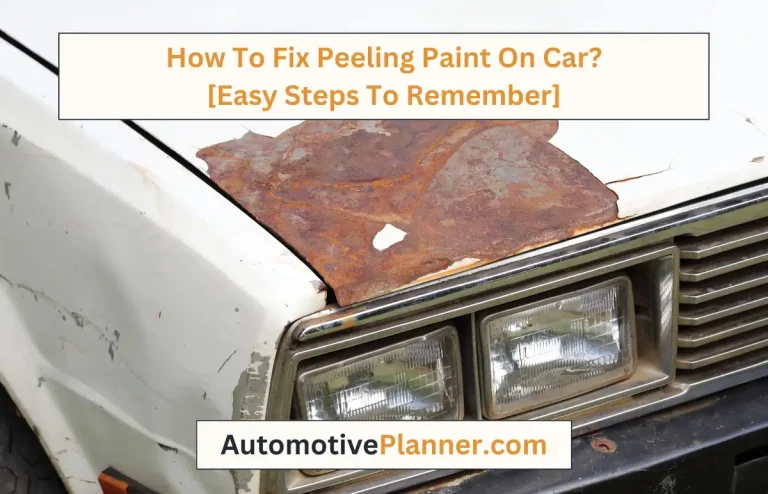Does Rain Damage Car Paint? [Know The Truth]
Many of us strive to keep our cars looking clean and shiny. But many obstacles hinder this desire. Does rain damage car paint is a question that often crosses the minds of car owners.
Rain alone does not immediately damage car paint. Impurities and acidity can contribute to wear over time. Modern automotive paints are designed to withstand rain and environmental elements. However, prolonged exposure to acidic substances in rain can lead to issues.
Here I will discuss the impact of rain on car paint, exploring the factors that contribute to the possible damage. Also, how rain can damage your car will be disclosed.
Types Of Rain That Damage Car Paint: Know The Culprits
While rain itself is generally harmless, certain variations, such as acid rain and heavy downpours with impurities, can pose threats to your car’s paint. In this guide, I’ll delve into the specific types of rain that can contribute to wear and tear.
Rain And Paint Damage Overview:
Rain, in its purest form, doesn’t pose a direct threat to car paint. However, it’s essential to recognize specific types of rain that can contribute to wear and tear on your vehicle’s exterior.
By understanding these variations, you can implement targeted measures to protect your car’s paint.
The Menace Of Acid Rain:
One of the primary culprits is acid rain. This environmental phenomenon occurs when pollutants such as sulfur dioxide and nitrogen oxides combine with moisture in the air, creating acidic precipitation.
When acid rain comes into contact with your car’s paint, it initiates chemical reactions that gradually erode and dull the surface. This poses a significant threat to the longevity and appearance of your vehicle’s paint job.
Other Contributors:
While acid rain is a prominent concern, it’s worth noting that other types of rain, especially hard or heavy rain containing impurities, can also impact your car’s paint.
Contaminants like dirt, dust, and minerals may not directly damage the paint, but their accumulation over time can affect the overall aesthetic appeal of your vehicle.
How Does Acid Rain Affect Car Paint?
Acid rain, a consequence of air pollutants interacting with atmospheric moisture, initiates chemical reactions that can compromise the protective layers of car paint. This paragraph explores the intricacies of these processes and the visible signs of damage.
Understanding Acid Rain:
Acid rain is a consequence of air pollutants, particularly sulfur dioxide and nitrogen oxides, reacting with moisture in the atmosphere. This forms acidic precipitation that, when it falls, can have detrimental effects on various surfaces, including car paint.
Chemical Reactions On Car Paint:
When acid rain makes contact with a car’s surface, it triggers chemical reactions. The acidic composition of the raindrops can lead to the gradual breakdown of the protective layers of the paint.
This process compromises the integrity of the paint, resulting in issues such as peeling, fading, and an overall dull appearance.
Accelerating Wear and Tear:
The chemical processes initiated by acid rain accelerate the natural wear and tear that a vehicle’s exterior experiences over time.
This acceleration can lead to substantial damage to the paintwork, affecting not only the visual appeal of the car but also its overall resilience and longevity.
8 Tips To Protect Car Paint From Rain:
This guide offers practical insights, from regular cleaning routines to the application of protective coatings and smart parking choices, ensuring your car maintains its luster and resilience despite exposure to varying weather conditions.
Tip 1: Understanding Rain’s Impact
Rainwater, while seemingly benign, often carries impurities and, in some cases, acidic elements. These can have adverse effects on your car’s paint over time, necessitating proactive protective measures.
Tip 2: Regular Cleaning Routine
Establish a consistent and thorough cleaning routine for your car. Regular washing is crucial to remove accumulated dirt, debris, and contaminants on the surface. This practice prevents the formation of water spots and minimizes the potential for mineral deposits from rainwater.
Tip 3: Application of Protective Coatings
Invest in high-quality protective coatings such as wax or sealants. These coatings create a protective barrier on the paint surface, reducing direct exposure to rainwater. They not only enhance the shine but also act as a shield against environmental elements.
Tip 4: Choose Covered Parking
Whenever possible, choose covered parking options. Whether it’s a garage, carport, or other shelter, covered parking provides a physical barrier that shields your vehicle from direct exposure to rain, preventing potential damage.
Tip 5: Consider Car Covers
Car covers designed for rain protection are a valuable investment. Opt for covers made from waterproof and breathable materials to ensure effective protection while allowing moisture to evaporate. This extra layer safeguards the paint from rain and other environmental factors.
Tip 6: Avoid Parking Under Trees
While trees provide natural shade, parking under them can introduce additional risks. Tree sap, bird droppings, and leaves mixed with rainwater create a corrosive mixture that can harm the paint. Choose parking spaces wisely to minimize such risks.
Tip 7: Regular Inspection and Maintenance
Perform regular inspections of your car’s paint. Look for signs of damage such as scratches, chips, or areas where the paint may be compromised.
Address these issues promptly to prevent further deterioration. Consider professional detailing and paint protection services for added resilience.
Tip 8: DIY Rain-Repellent Solutions
Explore do-it-yourself rain-repellent solutions for an added layer of protection. Homemade water repellents or commercial products designed to bead water off the surface can be applied to enhance the car’s resistance to rain.
Related questions:
Is There An Immediate Risk Of Paint Damage During Light Rain?
Light rain typically poses a minimal immediate risk of paint damage to your car. Modern automotive paints are designed to withstand light rain without significant harm. However, it’s essential to consider factors such as the frequency of exposure and the presence of impurities in the rainwater.
Over time, even light rain can contribute to the accumulation of contaminants on the car’s surface, potentially affecting its appearance.
Regular cleaning and maintenance, including waxing and protective coatings, can mitigate any gradual impact and ensure your car’s paint remains in optimal condition.
How Long Does Rain Damage Car Paint?
The duration for rain to damage car paint depends on various factors, including the intensity of the rain, the frequency of exposure, and the quality of the paint job. In general, rain alone, especially light rain, doesn’t cause immediate damage to modern automotive paints.
However, over time, consistent exposure to rain, particularly if it’s acidic or contains impurities, can contribute to gradual wear and tear.
Regular maintenance practices, such as washing and applying protective coatings, are crucial for preventing long-term damage and preserving the integrity of the car’s paint.
Will Rain Damage A Freshly Painted Car?
Rain can potentially pose a risk to a freshly painted car, depending on the specific circumstances. Newly painted cars often have paint that hasn’t fully cured or hardened, and they may be more susceptible to damage. It’s advisable to follow the recommendations of the paint professional regarding the curing time before exposing the car to rain.
If the paint has adequately cured, light rain is generally not a significant concern. However, heavy rain, acidic rain, or exposure to impurities may pose a higher risk and could affect the fresh paint job.
Taking precautions such as parking in covered areas or using car covers can help protect a freshly painted car from potential rain damage during the critical initial period.
Does Rain Wash Away Car Wax?
Rain can wash away car wax to some extent. While high-quality car waxes are designed to be water-resistant, heavy or frequent rain can gradually break down the wax layer on the car’s surface. This is especially true for natural waxes. However, synthetic waxes and sealants tend to offer longer-lasting protection.
It’s essential to regularly reapply wax to maintain optimal protection for your car’s paint. Also, using a reputable car wax product and ensuring the paint is thoroughly cleaned and dried before waxing can enhance the wax’s durability and effectiveness against rain.
Does The Color Of The Car Affect Its Vulnerability To Rain Damage?
The color of a car itself doesn’t directly affect its vulnerability to rain damage. However, the paint type and quality play a more significant role. Different paint finishes, such as metallic or pearl, may have varying levels of protection. The vulnerability to rain damage is more related to the condition of the paint, its protective coatings, and how well it has been maintained.
All cars, regardless of color, benefit from regular cleaning, waxing, and protective coatings to mitigate the potential effects of rain, such as water spots, mineral deposits, or damage from acidic rain.
Choosing high-quality paint and implementing proper maintenance measures are crucial factors in protecting any car’s exterior, regardless of its color.
Conclusion:
Newly painted cars may be more vulnerable, emphasizing the importance of proper curing and precautions. Taking remediation steps like Regular cleaning, protective coatings, and proactive measures, including choosing covered parking, are crucial.
Remember, the key to preserving your car’s paint is consistent maintenance and understanding the nuances of rain’s impact on different paint types and conditions. Hope, you know how does rain damage car paint.








